Like Sherlock’s deerstalker hat and signature cloak, the notion of Moriarty far exceeds his presence in the actual Conan Doyle canonical stories. In fact, Sherlock Holmes’ arch-nemesis only appears in two adventures; “The Final Problem” and “The Valley of Fear,” and both times more as plot device than a fully realized character. In this way, the various non-Doyle interpretations of Moriarty in both prose pastiches, film, television, or theatre have been more dynamic and instrumental in creating our idea of the character than the Moriarty presented in the original text.
But even with two appearances, the character of Moriarty could have been drawn a little more clearly than he was. Doyle mostly wanted to kill off Holmes and, as such, needed the ultimate bad guy. But some of Doyle’s other baddies were a little more developed than Moriarty. They, too, may have just been plot devices, but some of them were just as badass, and maybe a little more realistic than Moriarty.
Charles Augustus Milverton (“Charles Augustus Milverton”)
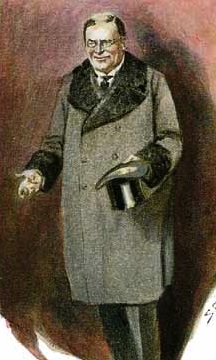 Though there is a story in the Holmes canon called “The Creeping Man” the story which contains Charles Augustus Milverton should maybe have been retitled “The Creepy Man.” Milverton is lecherous blackmailer with the most insidious of black books. He collects embarrassing odds and ends about the lives of various people and then extorts them for as much money as he can. Supposedly, Milverton was based on a real life art-dealer who was also a blackmailer named Charles Augustus Howell. In the grand scheme of Holmes villains who have a web of influence that the reader actually gets to see, Milverton is one of the best drawn. Finally, this villain is interesting because it indicates Holmes’ willingness to defend a virtue he cherishes perhaps more than justice—the right for all people to have a large amount of privacy.
Though there is a story in the Holmes canon called “The Creeping Man” the story which contains Charles Augustus Milverton should maybe have been retitled “The Creepy Man.” Milverton is lecherous blackmailer with the most insidious of black books. He collects embarrassing odds and ends about the lives of various people and then extorts them for as much money as he can. Supposedly, Milverton was based on a real life art-dealer who was also a blackmailer named Charles Augustus Howell. In the grand scheme of Holmes villains who have a web of influence that the reader actually gets to see, Milverton is one of the best drawn. Finally, this villain is interesting because it indicates Holmes’ willingness to defend a virtue he cherishes perhaps more than justice—the right for all people to have a large amount of privacy.
Col. Sebastian Moran (“The Empty House”)
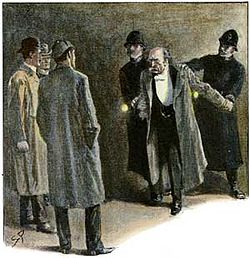 A sharpshooter with a long-distance air gun, Moran is one of the remaining members of Moriarty’s gang and is out for revenge in “The Empty House.” This story is famous as it features the official return of Sherlock Holmes from his presumed death in “The Final Problem.” (He had already returned in the form of a flashback in the novella The Hound of the Baskervilles.) Moran is dangerous in a more conventional way than some of creepos and schemers of other Holmes stories. In essence, Moran is an assassin who is very good at doing assassin stuff. In a sense, Moran is a bit of a foil to Watson insofar as both are ex-military who can handle a pistol. In the recent Guy Ritchie movie, A Game of Shadows, this notion is depicted literally with Watson squaring off against Moran with a variety of different firearms. Though Moran is basically just a slick trigger-finger for Moriarty, he does more direct killing than his boss, making him just a bit more hardcore. It also appears he just got his own tumblr.
A sharpshooter with a long-distance air gun, Moran is one of the remaining members of Moriarty’s gang and is out for revenge in “The Empty House.” This story is famous as it features the official return of Sherlock Holmes from his presumed death in “The Final Problem.” (He had already returned in the form of a flashback in the novella The Hound of the Baskervilles.) Moran is dangerous in a more conventional way than some of creepos and schemers of other Holmes stories. In essence, Moran is an assassin who is very good at doing assassin stuff. In a sense, Moran is a bit of a foil to Watson insofar as both are ex-military who can handle a pistol. In the recent Guy Ritchie movie, A Game of Shadows, this notion is depicted literally with Watson squaring off against Moran with a variety of different firearms. Though Moran is basically just a slick trigger-finger for Moriarty, he does more direct killing than his boss, making him just a bit more hardcore. It also appears he just got his own tumblr.
Henry “Holy” Peter (“The Disappearance of Lady Frances Carfax”)
Henry “Holy” Peter has many aliases and a long history of taking people into his confidence and convincing them to donate large sums of money to his various chartable causes. In the tragic story “The Disappearance of Lady Frances Carfax” Holy Peter convinces Lady Frances he is a philanthropic priest helping to spread the good word in Africa and save starving children. The well-meaning Lady Frances falls for it, and nearly winds up dead. Holy Peter’s plan includes burying Lady Frances alive in a casket secretly designed for two people. Holy Peter is so good at talking people into things that Holmes nearly doesn’t deduce what is really going on. Because Holmes and Watson are essentially late on the scene in the final moments of the story, Holy Peter is among the few schemers who briefly outsmarted everyone’s favorite detective.
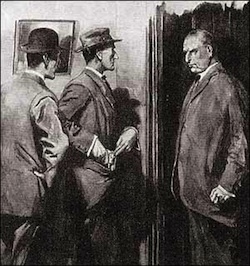
John Woodley (“The Solitary Cyclist.”)
With an “odious” visage and a body that constantly smells like booze, this guy isn’t so much of foil for Holmes, but rather a thug to be delt with. Woodley is involved in a complicated plot to forcibly marry Violet Smith in order to get her father’s fortune. He’s in league with a crackpot priest and who helps him perform a creepy shotgun wedding at the climax of the story. Notably, Woodley is one of a select group of people who Holmes takes down with his fists. In a particularly fantastic bar room brawl scene, Holmes shows Woodley one can both be a gentleman and a badass at the same time. Jeremy Brett interpreted this splendidly in the Granada Television 1984 version of the story. Watch above.
Irene Adler (“A Scandal in Bohemia”)
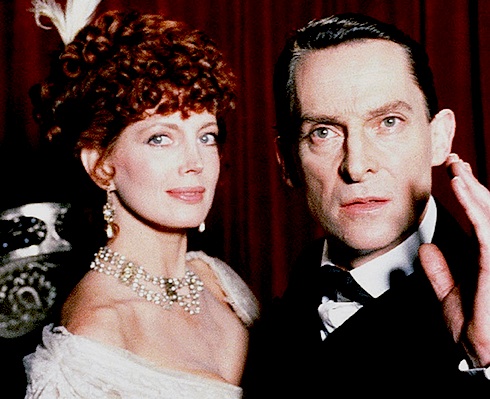
Behind Watson and Moriarty, Irene Adler is probably the most recognizable name from the original Holmes canon, even for those who have never actually read the stories. Irene Adler is the scandal in Bohemia, but is also the scandal in Baker Street too! Not only does Irene Adler impress Holmes with her blackmailing skill and her ability to disguise herself, she also turns him on a little bit. As anyone knows, Holmes frequently refers to her as “the Woman” not in a pejorative sexist way, but instead as a term of reverence and dare-we-say it—affection. Like Batman having his Catwoman, Holmes had Irene Adler.
 It’s interesting that this adventure is the first short story of the Conan Doyle canon insofar as the 56 stories make up far more of the backbone of the original texts than the four novels. If you one were to skip the novels and start here, they might assume Holmes became cold and unfeeling towards romance because of this story. In this way, “A Scandal in Bohemia” is to Holmes what Vesper’s suicide note is to James Bond in the novel Casino Royale. Smartly, Guy Ritchie brought Irene in on the action for the new films, and she’s set to show up on the 21st century Steven Moffat show too. However, perhaps the best non-canoical appearance of Irene Adler is in Nicolas Meyer’s The Canary Trainer where Irene is back to her roots, not as a blackmailer, but as an opera singer. She can shoot, steal, sneak, and sing. What a lady.
It’s interesting that this adventure is the first short story of the Conan Doyle canon insofar as the 56 stories make up far more of the backbone of the original texts than the four novels. If you one were to skip the novels and start here, they might assume Holmes became cold and unfeeling towards romance because of this story. In this way, “A Scandal in Bohemia” is to Holmes what Vesper’s suicide note is to James Bond in the novel Casino Royale. Smartly, Guy Ritchie brought Irene in on the action for the new films, and she’s set to show up on the 21st century Steven Moffat show too. However, perhaps the best non-canoical appearance of Irene Adler is in Nicolas Meyer’s The Canary Trainer where Irene is back to her roots, not as a blackmailer, but as an opera singer. She can shoot, steal, sneak, and sing. What a lady.
Ryan Britt is the staff writer for Tor.com. He admits to squeeing when Moran’s name was mentioned in the new Sherlock Holmes movie.










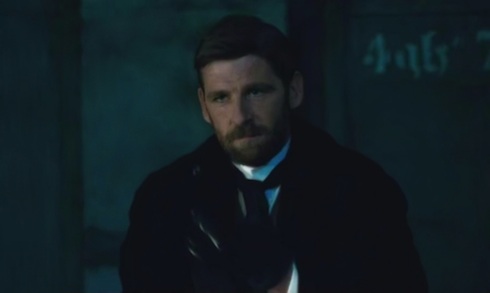
At the risk of sounding cranky, if you’re going to post about Holmes and Moriarty, can you at least spell Moriarty’s name right?
@1 Fixed! Thanks. We miss things every once and awhile. And we sound cranky sometimes too. :-)
Like Watson, Moran is also an author. If I recall correctly, Holmes’s file on him in “The Empty House” mentions two books on big game hunting.
Although I cannot recall their names, the antagonists in A Case of Identity and The Speckled Band have to rank in the top few for me. In each case the overall crime is made worse by the fact that the “perp” is the father of the victim.
In the former the father (in disguise) woos and discards his daughter to dissuade her from marrying (and thus costing the father his daughter’s inheritance). In the latter, the father dispenses with subtlety and simply attempts to kill his daughter (also for her inheritance).
@3 Nice point. That settles it. Moran is Evil Watson
@@.-@ Re: “The Speckled Band”- let’s not forget there’s a snake that needs to be killed in that one too! (That snake almost made my list)
Carole Nelson Douglas published a delightful series of books in which Irene Adler turns detective, FYI.
— Michael A. Burstein
Thanks for fixing the typo. Those things happen.
Evil Watson! I love it.
And in The Speckled Band, hasn’t the father already killed one of his daughters?
The villian in “The Adventure of the Speckled Band” was Dr. Grimesby Roylott, who was the step-father of Helen Stoner and her late twin sister, Julia. And yes, he was responsible for Julia’s death. A most excellent foe for Holmes (“When a doctor does go wrong he is the first of criminals. He has nerve and he has knowledge.”), but he got his comeuppance (“Violence does, in truth, recoil upon the violent, and the schemer falls into the pit which he digs for another.”). He was portrayed by the terrific Jeremy Kemp in the Jeremy Brett series.
Yeah, I’m a total Holmes geek.
@mabfan, I’ve read the first two of Douglas’ Irene Adler novels – delightful indeed! I should seek out the rest and read those as well.
Kim Newman’s Moriarty: The Hound of the d’Urbavilles is good fun. A series of short stories narrated by Moran in the style of Watson telling of Moriarty’s evil deeds and bringing in many characters from 19th Century fiction.
I am surprised that the sinster Stapleton of “The Hound of the Bashervilles” does not make your list. After all he was the villain of whom Holmes himself said: “I tell you, Watson, this time we have got a foeman who is worthy of our steel.”
What about the Baron Adelbert Gruner from the Illustrious Client? I think he’s one of the darker villains in the series. While Moriarty is certainly the more formidable (and dangerous) opponent of Holmes’, in the end he’s really just trying to run a business (albeit, a very illegal one); all of the pain he causes in the process is really just incidental for him, a means to an end.
The Baron, on the other hand, actually takes pleasure in victimizing people, he’s a predator. I mean, he “collects” women – that’s creepy.
I am really disappointed that Culverton Smith from “The Dying Detective” didn’t make it. That guy made Holmes ruining his own health just so he could pretend to die in order to make him confess. Yes, Smith didn’t intend that, but just think of the fact how much Holmes was forced to torment his own body via asceticism and other things. I mean even Watson thought that Holmes would die for good when he first saw him.
Or do you think he rather counts as a random villain? I’m personally not sure since he made Holmes go to such extremes, but then he didn’t have the threatening level of Milverton or Moriarty.